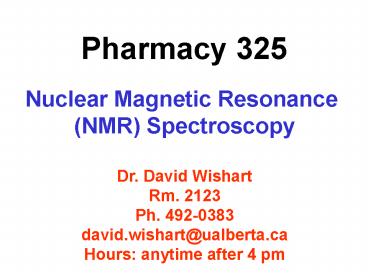Pharmacy 325 PowerPoint PPT Presentation
1 / 40
Title: Pharmacy 325
1
Pharmacy 325
Nuclear Magnetic Resonance (NMR)
Spectroscopy Dr. David Wishart Rm. 2123 Ph.
492-0383 david.wishart_at_ualberta.ca Hours anytime
after 4 pm
2
Lecture Notes Available At
- http//redpoll.pharmacy.ualberta.ca
- http//www.pharmacy.ualberta.ca/pharm325/
3
Electromagnetic Spectrum
4
Electromagnetic Spectrum
Hz
1021 1018 1015 1012
109 106
l (nm)
10-3 1 200 500 106 109
1012
Visible
Cosmic
X-ray
Ultraviolet
Radio
Microwave
Infrared
5
Different Types of NMR
- Electron Spin Resonance (ESR)
- 1-10 GHz (frequency) used in analyzing free
radicals (unpaired electrons) - Magnetic Resonance Imaging (MRI)
- 50-300 MHz (frequency) for diagnostic imaging of
soft tissues (water detection) - NMR Spectroscopy (MRS)
- 300-900 MHz (frequency) primarily used for
compound ID and characterization
6
NMR in Everyday Life
Magnetic Resonance Imaging
7
NMR Spectroscopy
8
Explaining NMR
UV/Vis spectroscopy
Sample
9
Explaining NMR
10
Principles of NMR
- Measures nuclear magnetism or changes in nuclear
magnetism in a molecule - NMR spectroscopy measures the absorption of light
(radio waves) due to changes in nuclear spin
orientation - NMR only occurs when a sample is in a strong
magnetic field - Different nuclei absorb at different energies
(frequencies)
11
Protons (and other nucleons) Have Spin
Spin up Spin down
12
Each Spinning Proton is Like a Mini-Magnet
Spin up Spin down
13
Principles of NMR
N
N
hn
S
S
Low Energy High Energy
14
Which Elements or Molecules are NMR Active?
- Any atom or element with an odd number of
neutrons and/or an odd number of protons - Any molecule with NMR active atoms
- 1H - 1 proton, no neutrons, AW 1
- 13C - 6 protons, 7 neutrons, AW 13
- 15N - 7 protons, 8 neutrons, AW 15
- 19F 9 protons, 10 neutrons, AW 19
15
The NMR Equation
n gB/2p
- B magnetic field strength in Tesla (1 Tesla
10,000 Gauss 1000 kitchen magnets) - g magnetic ratio (characteristic of each
nucleus, each atom in a molecule
16
Bigger Magnets are Better
Increasing magnetic field strength
low frequency high frequency
17
Different Isotopes Absorb at Different Frequencies
2H
15N
13C
19F
1H
30 MHz 50 MHz 125 MHz 480 MHz
500 MHz
low frequency high frequency
18
Typical 1H NMR Spectrum
19
NMR Units of Measurement
- Energies 10-6 eV
- Wavelength 30 cm - 100 cm
- Frequency 108 - 109 Hz
- Parts per million (d) 0 - 12 ppm (for 1H)
nobs - nref
x 106
ppm
nref
ppm is proportional to frequency
20
IR vs. NMR
Absorbance
21
NMR vs. IR
- NMR has narrower peaks relative to IR
- NMR yields far more information than IR
- NMR allows you to collect data on solids
liquids but NOT gases - NMR is more quantitative than IR or UV
- NMR samples are easier to prepare
- NMR is much less sensitive than IR or UV
- NMR spectrometers are very expensive
22
A Modern NMR Instrument
Radio Wave Transceiver
23
NMR Magnet
24
NMR Magnet Cross-Section
Sample Bore
Cryogens
Magnet Coil
Magnet Legs
Probe
25
An NMR Probe
26
NMR Sample Probe Coil
27
A Modern NMR Instrument
Radio Wave Transceiver
28
FT NMR
Free Induction Decay
FT
NMR spectrum
29
Fourier Transformation
iwt
F(w) f(t)e dt
Converts from units of time to units of frequency
30
1H NMR Spectra Exhibit...
- Chemical Shifts (peaks at different frequencies
or ppm values) - Splitting Patterns (from spin coupling)
- Different Peak Intensities ( 1H)
31
Chemical Shifts
- Key to the utility of NMR in chemistry
- Different 1H in different molecules exhibit
different absorption frequencies - Arise from the electron cloud effects of nearby
atoms or bonds, which act as little magnets to
shift absorption n up or down - Mostly affected by electronegativity of
neighbouring atoms or groups
32
Characteristic Chemical Shifts
33
Spin-Spin Coupling
- Many 1H NMR spectra exhibit peak splitting
(doublets, triplets, quartets) - This splitting arises from adjacent hydrogens
(protons) which cause the absorption frequencies
of the observed 1H to jump to different levels - These energy jumps are quantized and the number
of levels or splittings n 1 where n is the
number of nearby 1Hs
34
Spin-Spin Coupling
H
H
H
H
C - Y
C - CH
C - CH2
C - CH3
J
singlet doublet triplet
quartet
35
Spin Coupling Intensities
1 1 1 1 2 1 1 3 3 1 1 4 6 4 1 1 5 10 10 5 1
3 3
2
1 1
1 1
1 1
Pascals Triangle
36
NMR Peak Intensities
Y
Y
Y
C - CH
C - CH2
C - CH3
AUC 1 AUC 2 AUC 3
37
Applications
- Determination of exact structure of drugs and
drug metabolites - MOST POWERFUL METHOD KNOWN - Detection/quantitation of impurities
- Detection of enantiomers (shift reagents)
- High throughput drug screening
- Analysis/deconvolution of liquid mixtures
- Water content measurement
38
Metabonomics
- Analysis of blood, urine and other biofluid
mixtures to quantify and identify metabolite
changes - Allows one to detect drug toxicity and even
localize toxicity (for preclinical trials) in a
non-invasive way - Detection, identification and quantitation of
primary and secondary drug metabolites
39
Metabonomics
40
Other Applications
- Clinical testing (detection of inborn errors of
metabolism, cancer, diabetes, organic solvent
poisoning, drugs of abuse, etc. etc.) - Cholesterol and lipoprotein testing
- Chemical Shift Imaging (MRI MRS)
- Pharmaceutical Biotechnology (proteins, protein
drugs, SAR by NMR)

